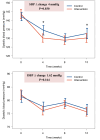Community-based intervention for monitoring of salt intake in hypertensive patients: A cluster randomized controlled trial
- PMID: 39576798
- PMCID: PMC11584128
- DOI: 10.1371/journal.pone.0311908
Community-based intervention for monitoring of salt intake in hypertensive patients: A cluster randomized controlled trial
Abstract
Background: Excessive sodium intake is associated with high blood pressure and an increased risk of cardiovascular disease. However, reducing dietary salt has been challenging due to a lack of awareness and a high threshold in detecting saltiness.
Objectives: The goal of this study is to evaluate the effectiveness of a combined intervention (intensive dietary education, food reformulation, environmental changes to facilitate salt reduction, and salt meter utilization), in comparison to standard education only, on salt intake and blood pressure.
Methods: A cluster randomized-controlled trial was conducted on 219 hypertensive adults aged 18 to 70 years in Uthaithani, Thailand. Participants were randomized 1:1 into the intervention group (n = 111) and the control group (n = 108).
Results: There were no differences in baseline characteristics between groups. The mean systolic and diastolic blood pressure was 143.6 and 82.1 mmHg and 142.2 and 81.4 mmHg in the intervention group, and the control group, respectively. The median 24-hour urinary sodium excretion was 3565 and 3312 mg/day, in the intervention and the control group, respectively. After 12 weeks, the change in systolic blood pressure was -13.5 versus -9.5 mmHg (P = 0.030) and diastolic blood pressure was -6.4 versus -4.8 mmHg (P = 0.164) in the intervention and control groups, respectively. Moreover, a reduction in 24-hour urine sodium excretion was observed [-575 versus -299 mg/day in the intervention and control groups, respectively (P = 0.194)]. The change in 24-hour urine sodium excretion was statistically significant and reduced from baseline in the intervention group (P = 0.004). The dietary salt intake was significantly improved and was statistically different between groups (P = 0.035).
Conclusions: The combined intervention significantly decreased systolic blood pressure and showed a trend towards reduced urine sodium excretion in hypertensive patients. These comprehensive approaches may be beneficial in reducing blood pressure and salt intake in the community.
Clinical trial registration: This trial was registered at Clinicaltrials.gov with the identifier NCT05397054. https://classic.clinicaltrials.gov/ct2/show/NCT05397054.
Copyright: © 2024 Sonuch et al. This is an open access article distributed under the terms of the Creative Commons Attribution License, which permits unrestricted use, distribution, and reproduction in any medium, provided the original author and source are credited.
Conflict of interest statement
The authors have declared that no competing interests exist.
Figures
Similar articles
-
The Salt Swap intervention to reduce salt intake in people with high blood pressure: protocol for a feasibility randomised controlled trial.Trials. 2019 Oct 11;20(1):584. doi: 10.1186/s13063-019-3691-y. Trials. 2019. PMID: 31604477 Free PMC article.
-
Effectiveness of an mHealth- and School-Based Health Education Program for Salt Reduction (EduSaltS) in China: Cluster Randomized Controlled Trial Within Scale-Up.J Med Internet Res. 2025 Mar 27;27:e60092. doi: 10.2196/60092. J Med Internet Res. 2025. PMID: 40017342 Free PMC article. Clinical Trial.
-
Effects of a Novel Contextual Just-In-Time Mobile App Intervention (LowSalt4Life) on Sodium Intake in Adults With Hypertension: Pilot Randomized Controlled Trial.JMIR Mhealth Uhealth. 2020 Aug 10;8(8):e16696. doi: 10.2196/16696. JMIR Mhealth Uhealth. 2020. PMID: 32663139 Free PMC article. Clinical Trial.
-
Impact of Salt Intake on the Pathogenesis and Treatment of Hypertension.Adv Exp Med Biol. 2017;956:61-84. doi: 10.1007/5584_2016_147. Adv Exp Med Biol. 2017. PMID: 27757935 Review.
-
Altered dietary salt intake for people with chronic kidney disease.Cochrane Database Syst Rev. 2021 Jun 24;6(6):CD010070. doi: 10.1002/14651858.CD010070.pub3. Cochrane Database Syst Rev. 2021. PMID: 34164803 Free PMC article.
References
-
- WHO Guidelines Approved by the Guidelines Review Committee. Guideline: Sodium Intake for Adults and Children. Geneva: World Health Organization
Publication types
MeSH terms
Substances
Associated data
LinkOut - more resources
Full Text Sources
Medical




